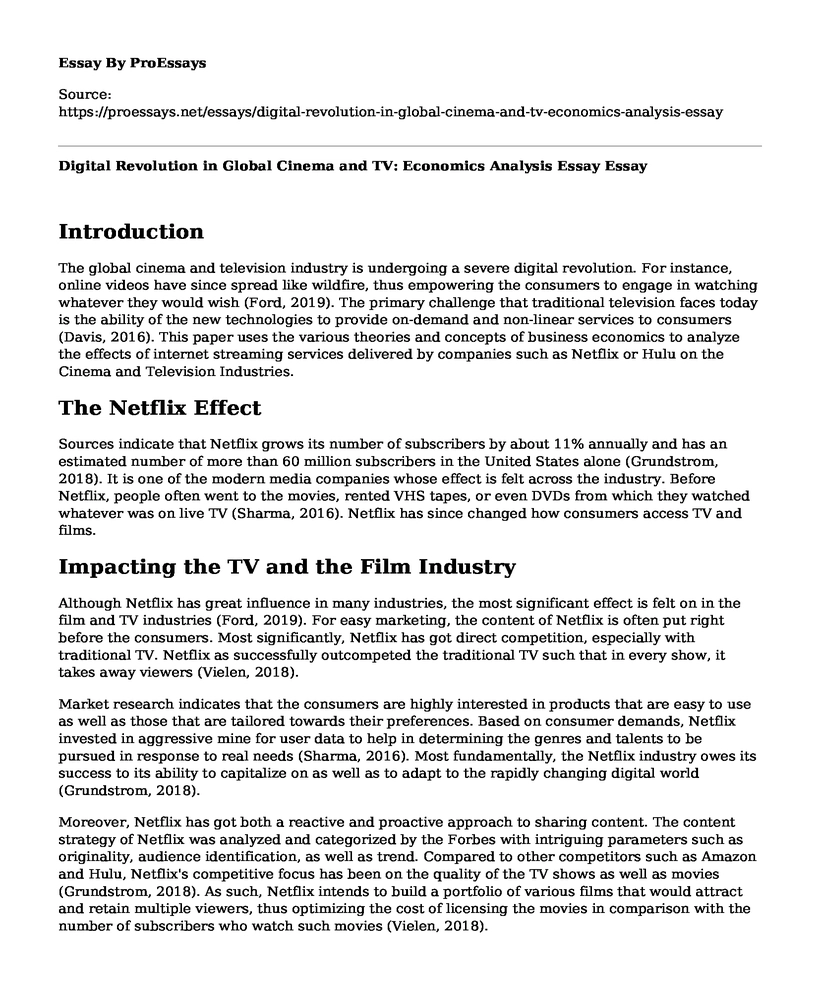Introduction
The global cinema and television industry is undergoing a severe digital revolution. For instance, online videos have since spread like wildfire, thus empowering the consumers to engage in watching whatever they would wish (Ford, 2019). The primary challenge that traditional television faces today is the ability of the new technologies to provide on-demand and non-linear services to consumers (Davis, 2016). This paper uses the various theories and concepts of business economics to analyze the effects of internet streaming services delivered by companies such as Netflix or Hulu on the Cinema and Television Industries.
The Netflix Effect
Sources indicate that Netflix grows its number of subscribers by about 11% annually and has an estimated number of more than 60 million subscribers in the United States alone (Grundstrom, 2018). It is one of the modern media companies whose effect is felt across the industry. Before Netflix, people often went to the movies, rented VHS tapes, or even DVDs from which they watched whatever was on live TV (Sharma, 2016). Netflix has since changed how consumers access TV and films.
Impacting the TV and the Film Industry
Although Netflix has great influence in many industries, the most significant effect is felt on in the film and TV industries (Ford, 2019). For easy marketing, the content of Netflix is often put right before the consumers. Most significantly, Netflix has got direct competition, especially with traditional TV. Netflix as successfully outcompeted the traditional TV such that in every show, it takes away viewers (Vielen, 2018).
Market research indicates that the consumers are highly interested in products that are easy to use as well as those that are tailored towards their preferences. Based on consumer demands, Netflix invested in aggressive mine for user data to help in determining the genres and talents to be pursued in response to real needs (Sharma, 2016). Most fundamentally, the Netflix industry owes its success to its ability to capitalize on as well as to adapt to the rapidly changing digital world (Grundstrom, 2018).
Moreover, Netflix has got both a reactive and proactive approach to sharing content. The content strategy of Netflix was analyzed and categorized by the Forbes with intriguing parameters such as originality, audience identification, as well as trend. Compared to other competitors such as Amazon and Hulu, Netflix's competitive focus has been on the quality of the TV shows as well as movies (Grundstrom, 2018). As such, Netflix intends to build a portfolio of various films that would attract and retain multiple viewers, thus optimizing the cost of licensing the movies in comparison with the number of subscribers who watch such movies (Vielen, 2018).
Furthermore, Netflix has invested in partnerships with other leading organizations such as Apple. They have also encouraged direct sign up for the owners of Apple TV. This move was ideally to have the chance of accessing the large customer base for Apple, while for Apple, the partnership was a chance to provide its customers with more content in some convenient ways (Ford, 2019). By around the year 2005, Netflix had started offering the 'on-demand' videos and TV streaming services to the consumers. The most distinguishing factor between Netflix and the traditional streaming services is that in Netflix, a person could watch at his or her convenience. As such, the new digital technology permits the watching from any screen, including laptop, TV, and mobile (Sharma, 2016).
References
Davis, B.C., 2016. The Netflix Effect and Defining Binge-Watching.
Ford, J., 2019. The Netflix Effect: Technology and Entertainment in the 21st Century, Kevin McDonald and Daniel Smith-Rowsey (eds) (2016). Journal of Digital Media & Policy, 10(1), pp.127-129.
Grundstrom, H., 2018. What digital revolution? Cinema-going as practice. Participations. Journal of audience and reception studies, 15(1), pp.5-22.
Sharma, R.A., 2016. The Netflix effect: Impacts of the streaming model on television storytelling.
Vielen, DH, 2018. The Netflix Effect? On updating the cinematic apparatus theory (Master's thesis).
Cite this page
Digital Revolution in Global Cinema and TV: Economics Analysis Essay. (2023, Apr 23). Retrieved from https://proessays.net/essays/digital-revolution-in-global-cinema-and-tv-economics-analysis-essay
If you are the original author of this essay and no longer wish to have it published on the ProEssays website, please click below to request its removal:
- Political Symbolism Essay
- Essay Sample on Good Etiquette on Social Media
- The Grapes of Wrath Play Analysis Paper Example
- Essay on Genre Theory: A Strategic Study of Films & Audience Engagement
- Movie Analysis Essay on Life of Pi: A Journey of Belief, Discovery and Devotion
- The Big Short: Examining the Causes of the 2007-2008 Financial Crisis - Essay Sample
- Report Sample on 21st Century News: A New Media Reality







